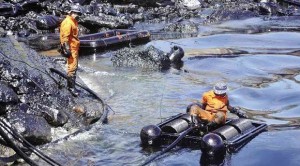
FILE PHOTO
MANILA, Philippines — The Philippine Coast Guard said on Wednesday it has started efforts, along with local cleanup teams, to contain the oil sheen and oil drops that were detected off Guimaras, following the sinking of a cargo ship last Sunday.
Commodore Athelo Ybañez, commander of the Coast Guard District Western Visayas based in Iloilo City, said the portions of the shores in at least two barangays (villages), Hoskyn and Rizal, in the Jordan town, the capital or Guimaras, bore signs of oil contamination.
“[The oil contamination] is very minimal. We just found traces,” Ybañez told reporters in a phone patch interview.
“It’s the not the entire barangays [shoreline] that have been affected, but only certain portions. What we saw were just spots. There were also drops that probably have regrouped [from smaller drops] and bubbles of possible bunker oil, some of which have reached the shore,” he added.
In Hoskyn, he said, PCG and local cleanup personnel saw traces of bunker oil on the rocks and other debris in some areas along the shore. In Rizal, oil has reached the wharf.
The PCG has been on alert since Sunday following the sinking of the MV Sportivo, which had collided with another vessel amid rough seas. The Sportivo carried about 12,000 liters of fuel oil and the PCG were confirming reports that the crew failed to shut the fuel valves before the ship was abandoned.
“But fuel oil was detected so either the valves were not shut, or the fuel lines have burst, or there are other sources of leakage,” he said.
He said the two-kilometer long oil sheen earlier detected could reach the coast communities, depending on the changes in the sea current.
Ybañez said PCG divers were able to reach the sunken vessel on Tuesday but failed to inspect its bottom side due the strong current and poor visibility. The divers will return after the weather improves and put markers so that passing ships could be aware about the site.
Oil spill booms were also not placed because of the rough sea so the PCG cleanup crew have been using oil dispersants, he said.
Ybañez said that Guimaras fisherfolk and coastal residents, upon hearing about the sinking, immediately deployed improvised oil spill booms made of rice straw.
The coast guard official said the health, environment and fisheries agencies would assess the level of contamination and its effect on the environment, especially on air and water quality.
He said he personally asked an expert about the damage that could be caused by the 28,000 sacks of fertilizer in the Sportivo’s cargo compartment and was told that the fertilizer would dissolve in seawater and scattered by the current.
Guimaras suffered an ecological disaster in August 2006 when a tanker carrying 2.4 million liters of oil sank off the island. Nearly 30 square kilometers of the shore, including mangrove forests and marine sanctuaries, were contaminated in what has been regarded as the country’s worst oil spill.
RELATED STORY
Guimaras villagers brace for oil spill